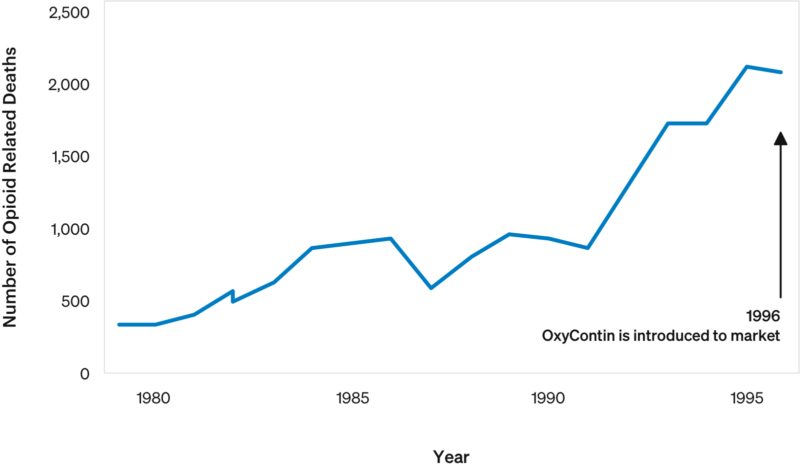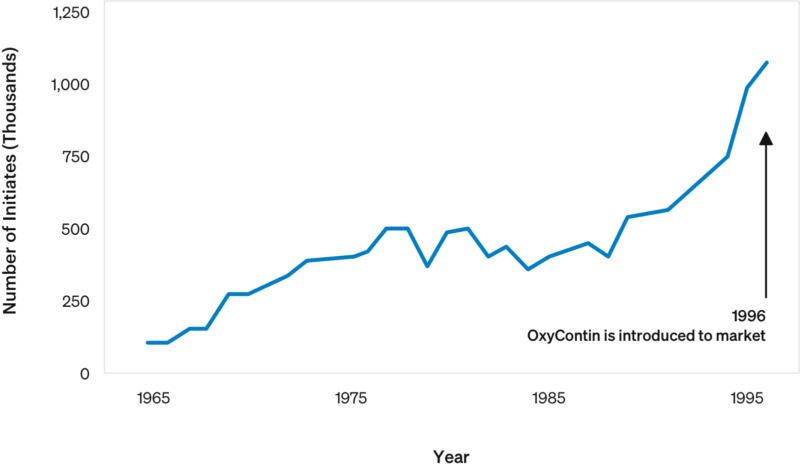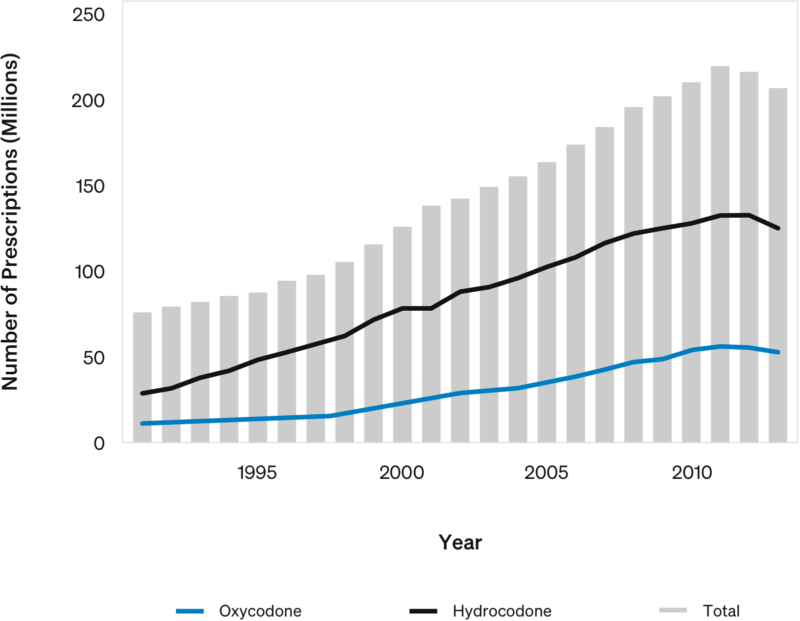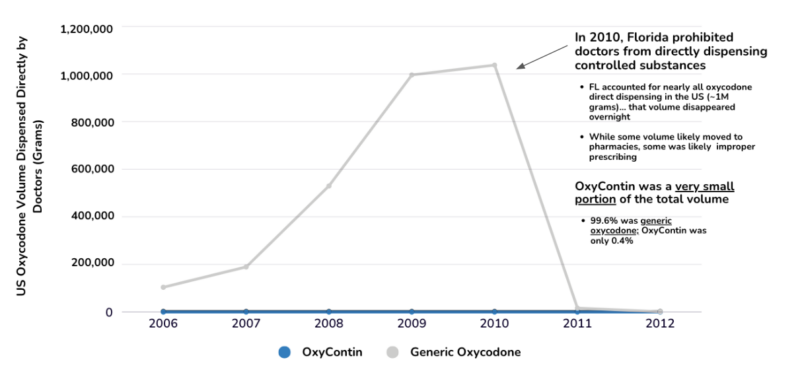OxyContin Did Not Create Opioid Crisis
OxyContin has been incorrectly blamed for triggering the opioid crisis. The reality is that opioid prescriptions were growing rapidly long before OxyContin was introduced in 1996 — and the medicine was never more than 4% of opioid prescriptions.
Prescriptions for opioids, the abuse of prescription opioids and opioid-related overdose deaths were growing steadily before OxyContin was introduced – and the proliferation of pill mills exacerbated the crisis.
Abuse of Prescription Opioids Pre-Dates Launch of OxyContin
The abuse of prescription opioids was growing steadily before the introduction of OxyContin in 1996. In addition, prescriptions for opioids were rising significantly and opioid-related overdose deaths were growing steadily before OxyContin was introduced.
May 2018[1]
America’s 150-Year Opioid Epidemic
All opioids – whether prescription medicines or illicit drugs like heroin and illicit fentanyl – have been known to be addictive since the Sumerians in 3400BC referred to poppies as the “joy plant.”[2] Morphine was invented in the early 1800s and was also known to be addictive.[3] Potential for addiction or abuse involving prescription opioids must be balanced with medical necessity for an individual patient.
In fact, over the last 150 years, opioid abuse has been the subject of novels and films:
1870
“The Mystery of Edwin Drood”
Charles Dickens depicts opium smokers with shaky hands, convulsing, dribbling at the mouth
Charles dickens[4]
1891
“The Man With the Twisted Lip”
“much addicted to opium. … a slave to the drug… I can see him now… the wreck and ruin of a noble man.”
Sherlock Holmes[5]
1989
“Drugstore Cowboy”
Lionsgate movie illustrates how opioid abuse was growing years before OxyContin was launched.
Lionsgate[6]
Government Statistics: OxyContin Did Not Create Opioid Crisis
U.S. Drug Overdose Deaths Involving Opioids: 1979-1996[7]

Estimated Numbers of Persons Who First Misused Prescription Pain Relievers in the U.S.: 1965–1996[8]

“The Shady Statistics Behind the War on Painkillers”[9]
Statistician and Reason.com author Aaron Brown demonstrates how the federal government has been relying on skewed data to prove its false assertion that an increase in prescription opioid sales led to increase in overdose deaths.
Experts: OxyContin Did Not Create Opioid Crisis
“This is merely the newest part of a prescription opioid diversion and abuse problem that has been rising since the mid-1980s… [T]he incidence of new prescription opioid abuse and the number of new prescription opioid abusers has been rising steadily since well before the introduction of OxyContin.”
Dr. H. Westley Clark, Director, HHS-SAMHSA Center for Substance Abuse Treatment, February 12, 2002[10]
“The U.S. drug overdose epidemic has been inexorably tracking along an exponential growth curve since at least 1979.”
September 21, 2018[11]
“Holding Purdue solely responsible for the entire opioid epidemic in North Dakota is difficult to comprehend, especially given Purdue’s small share of the overall market for lawful opioids. It is also difficult to comprehend given the large market for unlawful opioids.”
James S. Hill, District Judge for South Central Judicial District of North Dakota, May 10, 2019[12]
“Research shows the overdose rate has been climbing exponentially since at least the late 1970s, long before the creation of the potent prescription opioid OxyContin in 1996, and continues to climb.”
December 23, 2020[13]
“The roots of the problem go back a long way. Since the 1980s, America’s drug-overdose death rates have increased at the terrifyingly steady clip of 7.6% per year.”
The Economist, July 2021[14]
“[Appalachia] has always had a prescription pill problem for decades, way before even the Purdue Pharma case…”
Rick Mountcastle, Assistant Attorney General State of Virginia, February 2022[15]
“Research shows that drug overdose deaths have increased every year since 1978, [Douglas Tucker] said, beginning before the introduction of the blockbuster opioid OxyContin by Purdue Pharma in 1996 and the issues in the litigation before the court.”
Testimony from addiction specialist Douglas Tucker in San Francisco opioid trial, June 2022[16]
“… blame for oxycodone’s horrors should go way beyond Purdue Pharma.”
Simon Sobo, M.D., November 2022[17]
“In the 1960s, rising addiction rates in American cities coupled with increasing heroin use among U.S. soldiers returning from Vietnam caused President Richard M. Nixon to take notice.”
Zoe Adams, resident physician in internal medicine at Massachusetts General Hospital, April 2023[18]
Opioid Prescriptions Were Rising Before OxyContin Was Introduced in 1996
“Between 1979 and 1985… consumption of oxycodone and hydromorphone rose 40 percent and 67 percent, respectively, according to DEA figures.”
January 1997[19]
Opioid Prescriptions Dispensed by U.S. Retail Pharmacies: 1991-2013[20]

“If Not Purdue, Who Drove the Epidemic?” Asks The Washington Post
“It is one of the biggest stories of our time and it was hiding in plain sight: How did the opioid epidemic overtake America?
The prevailing narrative offered a too-easy scapegoat… But the epidemic took off after Purdue was brought to heel and fined $600 million. If not Purdue, who drove the epidemic? And why didn’t anyone stop them?”
May 4, 2020[21]
“Purdue is just one character on a crowded stage. During the height of the crisis, from 2006-2012, Purdue’s sales represented only 3 percent of the market.”
July 20, 2019[22]
“Purdue Pharma, which the plaintiffs allege sparked the epidemic in the 1990s with its introduction of OxyContin, its version of oxycodone, was ranked fourth among manufacturers with about 3 percent of the market.”
JULY 16, 2019[23]
10 Biggest Prescription Opioid Manufacturers: 2006-2012[23]
| Manufacturer | Number of Pills | Market Share |
|---|---|---|
| SpecGx | 28,863,435,081 | 37.7% |
| Actavis Pharma | 26,476,395,830 | 34.6% |
| Par Pharmaceutical | 11,996,780,871 | 15.7% |
| Purdue Pharma | 2,492,496,319 | 3.3% |
| Amneal Pharmaceuticals | 2,257,973,121 | 2.9% |
| Teva Pharmaceuticals USA | 686,276,053 | 0.9% |
| KVK Tech | 580,825,207 | 0.8% |
| West-Ward Pharmaceuticals | 384,200,988 | 0.5% |
| Kaiser Foundation Hospitals | 366,492,050 | 0.5% |
| Endo Pharmaceuticals | 297,306,324 | 0.4% |
“Hydrocodone is the most frequently prescribed opioid in the United States and is associated with more drug abuse and diversion than any other licit or illicit opioid.”
dEA drug Fact Sheet[24]
Proliferation of Pill Mills Exacerbated the Crisis
The proliferation of pill mills exacerbated the opioid crisis. Yet even pill mill data shows OxyContin was not commonly sold. For example, in 2010, Florida doctors directly dispensed 1 billion mg of oxycodone pills – and OxyContin accounted for less than 0.5% of those prescriptions.
